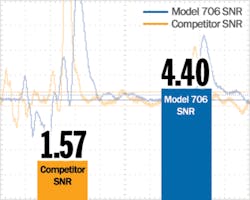In ethylene plants, balancing environment, health, and safety, while maximizing productivity, is essential. In this regard, level instrumentation plays a key role in preventing loss of primary containment and maintaining a safe environment inside of the tank. This is critical, because incident consequences are significant, with the direct cost of a work-related death estimated at $1M and indirect costs nearly four times greater.*
Level instruments can also assist in ethylene applications by maximizing productivity, including interface-type measurement in some of the harshest environments.
Today, conformance to IEC 61508 is the standard for reliability. Instruments with the appropriate SIL requirements are suitable for use in SIL 1, SIL 2 or SIL 3 safety loops as a single device or with redundancy. Level instruments that conform to the latest safety standards, including SIL requirements, are capable of assisting in the most critical applications in ethylene plants. The following article covers a series of application scenarios where level instruments were leveraged to the advantage of ethylene-related processes.
Interface level for ethylene quench tower/settler
Application & Challenges:
Feedstock comes into the plant and goes through the ethylene furnaces (pyrolysis). Once cracked into a variety of hydrocarbons and hydrogen, it immediately begins to recombine into larger molecules. To prevent these reactions, the cracked vapor goes through the quench tower to cool using oil or water. The largest hydrocarbons are carried with the water into the quench settler or the quench water separation drum (QWSD).
Quench tower and settlers can become a bottleneck when attempting to maximize production. As feedstock is increased, more cooling fluids are required. The residence time in the settlers needs to be minimal to maintain composition and prevent secondary reactions (including larger chains or heavier hydrocarbons).
Solution:
A quench settler or QWSD that catches the hydrocarbon liquids and water from the quench tower creates an interface in the QWSD and possibly an emulsion layer if too much caustic is added. The interface is important to recirculate the quench water from the settler to the tower and not recirculate the hydrocarbons, which will reduce productivity and potentially cause fouling of equipment (also applies to quenching oil versus tars and other heavy hydrocarbons).
If the quench water or oil is not recycled correctly from the quench settler, it can cause fouling problems with equipment and degrade the fluid composition from the furnaces. If too much fouling occurs or the fluid composition changes for the worse in the quench tower, less ethylene is eventually produced from the feedstock. This is why interface level measurement is critical. While QWSDs have traditionally been equipped with differential pressure systems, guided wave radar or magnetostrictive level measurement technologies offer significant advantages.
Guided-wave radar level for multiphase measurement
Application & Challenges:
One of the world’s largest oil & gas and petrochemical companies faced challenges with multiphase applications involving hydrocarbon level with water bottoms and gas vapor space. Guided wave radar was being used, but it did not produce a reliable signal throughout the length of the probe, and the interface made it difficult to distinguish between upper level and water below. This threatened loss of primary containment (LOPC) due to the error in measurement.
Solution:
When tested side-by-side with the existing solution, the GWR level instrument tracked level up to the device’s flanged process connection (above 100 percent level point), even with water bottoms. There were no dead zones or blind spots at top of probe. The new solution prevented LOPC and provided superior signal strength through the hydrocarbon level down to the water level.
Advantages of GWR:
- Direct level measurement independent of specific gravity (SG) or other media characteristics
- No calibration or capillary tubing
- Direct-mounted or installed in chamber
- Advanced diagnostics with waveform capture and buildup detection
- Quick setup and no moving parts
- Effective for interface applications as the pulse is reflected from the upper surface, with some energy continuing down the probe to the higher dielectric liquid
- Supports safety critical applications such as overfill protection
- Suitable for use in SIL 2/3 loops (manufacturer dependent)
Magnetostrictive level measurement for safety systems
Application & Challenge:
A refinery and petrochemical facility in Canada that primarily produces ethylene was looking for an effective solution to a challenging level measurement application. The facility’s reliability and safety groups needed level devices that met SIL requirements for emergency shutdown (ESD) and safety systems. Both SIL 1 and SIL 2 applications existed at the site.
The facility needed to implement proof-test procedures for its instrumentation and control devices to meet safety loop requirements. One proof-test requirement was for the mA output to be set below 4 mA and above 20 mA; this was the necessary output range to meet the NAMUR NE43 recommendation.
Solution:
The selected magnetostrictive transmitter allowed current output to be taken low or high per NAMUR NE43. The advanced diagnostics of transmitter allowed users to pull echo curves from the transmitter display or access them externally using a PC by wiring into the current loop.
Advantages of magnetostrictive:
- Proven technology particularly in interface with large emulsion layer and advanced diagnostics with waveform capture
- Capable of providing very small SG differences between upper and lower liquid (0.96/0.973)
- Constructed for high pressure due to flashing potential
- Supports interface of oil/water or water/oil and multiple points with floats sized to different SGs
- SIL ratings available
For more information on level measurement solutions for ethylene plant safety and efficiency, download the ethylene applications brochure.
This content is sponsored by Magnetrol International. Sponsored content is authorized by the client and does not necessarily reflect the views of the Process Flow Network editorial team.
* National Safety Council, "Injury Facts," www.nsc.org/learn/safety-knowledge/Pages/injury-facts.



